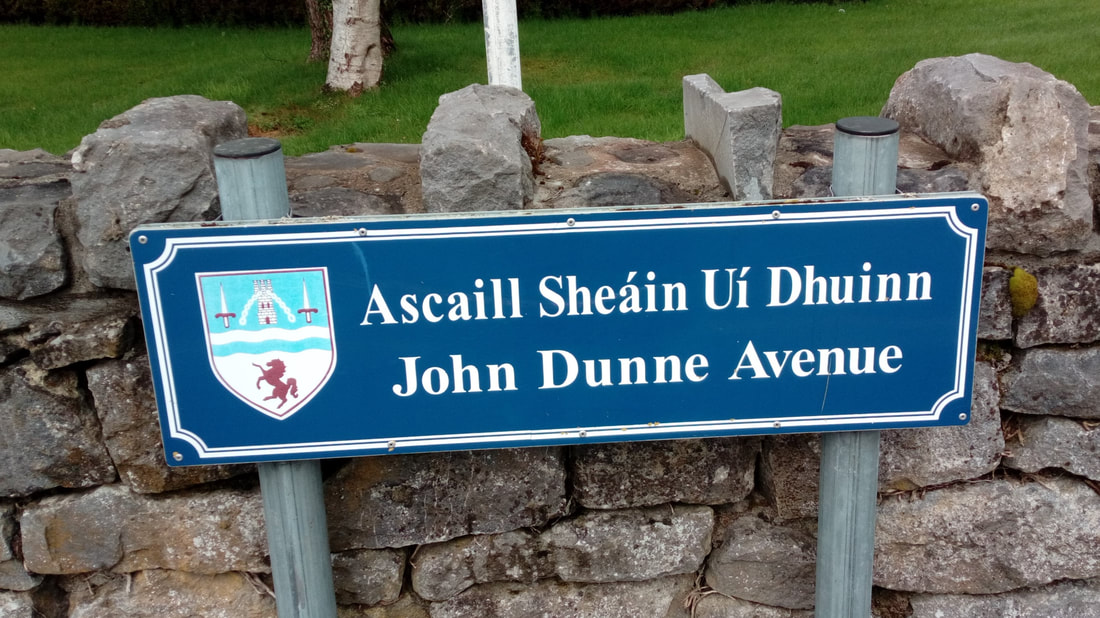|
by Barry Lally WHAT’S IN A NAME?
“A prophet is not without honour, but in his own country, and among his own kin, and in his own home.” Take a good look at the accompanying photograph. Why? Because it features something unique: the only local street sign bearing the name of a Ballinasloe native – and no, Harris and McNevin don’t count, they were from Roscommon town and Aughrim respectively. It isn’t that the town is short of individuals from the past who distinguished themselves in their chosen fields by a combination of talent and application. We can think of names such as John O’Connor Power, one of the most celebrated parliamentary orators of his day; George Brent (Nolan), born in a Main Street pub, who rose to major stardom in the fiercely competitive world of 1930s Hollywood; Dr. Andrew Horne, an eminent obstetrician and co-founder of Holles Street Maternity Hospital, performed the first successful Caesarean section in Ireland, and who figured in the pages of James Joyce’s “Ulysses”; Emily O’Shaughnessy, born during the Great Famine, emigrated as a child to Australia where she became a pioneering and much-feted portrait photographer; Eoghan Ó Tuairisc (Eugene Watters), widely regarded as the most versatile creative writer in Irish to come from a non-Gaeltacht background. Not one of the foregoing has ever been honoured in a permanent and public manner by the community he or she hailed from To appropriate memorialize the notables of other days would contribute significantly to making the town more interesting for both visitors and locals alike, and would also foster a legitimate pride in the achievements of past generations. This, however, should not be done by re-naming street or housing estates. Place names are reflective of the times in which they were acquired and encourage curiosity about their origins. Whether or not such names chime with current attitudes is irrelevant, and to change them, especially if they are long-standing, can be seen as a kind of cultural vandalism. From my schooldays I recall a teacher who would wax indignant at the thought that there were people in town who would prefer Duggan Avenue to be still called Victoria Street. Similarly, Todd Andrews, IRA veteran and former chairman of CIE, bitterly lamented in one of his autobiographies that in post-Independence Dublin there were streets that continued to carry the names of viceroys and other British officials. Individuals who had lived through and supported a revolution promising the transformation of Irish society often lacked the requisite maturity appreciate the diversity of our heritage and viewed relics of the “ancient régime”, be they in the form of place names, monuments, or even buildings, as jeopardizing the success of a project for which many of their contemporaries had fought and suffered. An egregious example of this mindset was the decision (not acted on) of Athlone Urban Council in the 1960s to demolish the castle in the centre of the town because it had been built by the Anglo-Normans. Another phenomenon that has latterly come to the fore is the reprehensible practice of judging the past by the standards of the present, as exemplified by Trinity College’s recent move to de-name the Bishop Berkeley Library after it was revealed that the philosopher had owned slaves in America. If name-changing in not on the agenda when it comes to honouring the distinguished departed, what is to be done? Locally there are several building developments, either currently progressing or on the horizon, that are as yet anonymous and will present a cost-free opportunity to make amends for past neglect. But the story shouldn’t end there. Something more visible is required in addition. The display stands positioned at various points around the streets could be used to feature potted biographies. As well, the scheme that has been ongoing in Galway City since the early 2000s should be looked at. This consists of bronze commemorative plaques, often free-standing or attached to walls in the neighbourhood. They usually incorporate quotations attributed to the persons in question, an undoubted improvement on bald statements of fact. Perhaps it would not be overly-optimistic to look forward to a day in the not-too-distant future when footballer “Tull” Dunne, good and all as he was, will finally lose his uniqueness.
1 Comment
19/12/2023 01:45:42 pm
What an intriguing perspective on honoring local figures! If I may ask, who would you suggest as a suitable figure for such recognition in Ballinasloe?
Reply
Leave a Reply. |
CLICK HERE to read the Latest Ballinasloe News Articles
June 2024
|
The Town Team was set up by BACD Ltd. to revive the fortunes of Ballinasloe and its hinterland. With the main focus to build on the town’s many strengths, change existing negative perceptions and bring about measurable improvements in the town centre economy and its wider social value.
|
Ballinasloe Area Community Development Ltd.
Ballinasloe Enterprise Centre Creagh Ballinasloe Co. Galway |
All generic photos and images have been sourced and are free of copyright or are clip art images free of copyright. Photos of Ballinasloe have been donated by BEC. If you have any photos that you would like included on the website please email us
Copyright © All rights reserved, 2024 BACD


 RSS Feed
RSS Feed
